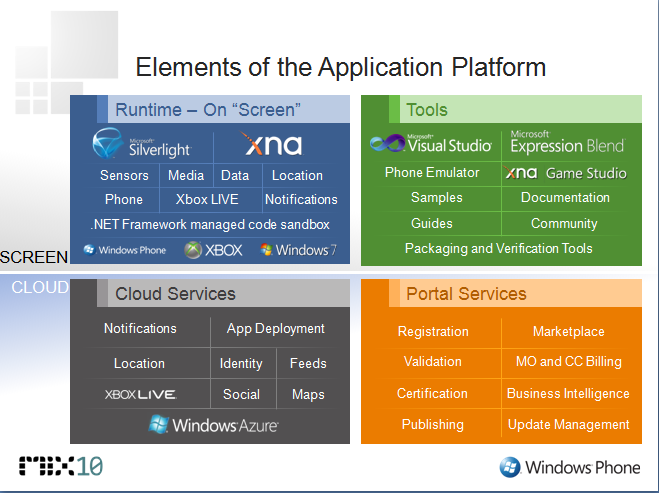The Windows Phone 7 app platform: One slide says it all

There's been a lot of new (and sometimes conflicting/confusing) information shared this week about Microsoft's Windows Phone 7 platform at the Microsoft Mix 10 conference.
Microsoft officials admitted that the phone team made a conscious decision to eliminate cut-and-paste functionality from the initial Windows Phone 7 platform. (They won't say if or even whether Microsoft may add cut-and-paste to the phone platform, despite the fact that Windows Mobile currently has that capability.) This just in: Microsoft's latest statement on the lack of cut-and-paste: "We’re always listening to feedback and will continue to improve our feature set over time based on what we hear." (So I'll take that as a maybe it's coming sometime, but not in the initial version....)
The team also conceded that multitasking is going to be a mixed bag on Windows Phone 7 devices (with Microsoft apps/experiences having the capability but third-party apps not so).
Most tellingly, Microsoft execs admitted that Windows Phone 7 devices' initial target audience is consumers, not business users. (I guess the "life maximizers" Microsoft sees as the buyers for these phones aren't expected to do a whole lot of work on their WP7 phones.) As my blogging colleague Larry Dignan noted yesterday, Microsoft's iPhone envy may have gotten the best of the company.
A picture is worth a thousand words. This slide from Windows Phone 7 team member Charlie Kindel's talk at Mix -- which shows all of the various elements of Microsoft's Windows 7 phone app platform in architectural diagram form -- provides a quick overview of what the Softies are telling developers and designers this week about the company's next-gen mobile platform. (Click on the slide below to enlarge.)
Microsoft reiterated this week that Silverlight is the primary vehicle for writing Windows Phone 7 applications and some games. XNA Game Studio is for developers who want to build highly interactive and/or 3D games.
Microsoft isn't sharing anything about what's happening with its My Phone synchronization service that it introduced last year for Windows Mobile users, but the Softies are saying there will be some cloud services available (and still unknown prices) to Windows Phone 7 users, including notification, app deployment, social and Xbox Live gaming. There will be additional "portal services" available to Windows Phone 7 users, as well -- everything from update management, to billing, to app purchasing (which will be handled, for now, at least, exclusively through the Windows Phone Marketplace.
I'm still curious as to when and whether Microsoft will flesh out the Windows Phone 7 platform to make it more attractive to enterprise customers. What else are you still wondering about, regarding Microsoft's next steps with mobile?
